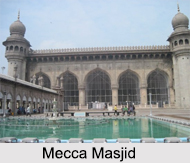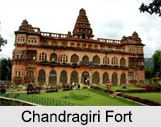 Monuments of South India lie untouched and resplendent along the shores of the three oceans that surround and protect its beauty. The region is separated from the north by the Vindhya Range and insulated on the east and west by the eastern and Western Ghats. Consequently the culture, architecture and heritage of the place have remained largely untouched. The Dravidian style of construction has remained intact and can be plainly seen in all the temples and monuments that adorn this idyllic region. South India comprises primarily of 5 different states - Kerala, Tamil Nadu, Karnataka, Telangana and Andhra Pradesh as well as the Union Territories of Puducherry and the Lakshadweep archipelago.
Monuments of South India lie untouched and resplendent along the shores of the three oceans that surround and protect its beauty. The region is separated from the north by the Vindhya Range and insulated on the east and west by the eastern and Western Ghats. Consequently the culture, architecture and heritage of the place have remained largely untouched. The Dravidian style of construction has remained intact and can be plainly seen in all the temples and monuments that adorn this idyllic region. South India comprises primarily of 5 different states - Kerala, Tamil Nadu, Karnataka, Telangana and Andhra Pradesh as well as the Union Territories of Puducherry and the Lakshadweep archipelago.
Classification of Monuments of South India
Monuments of South India are mainly of two types: religious and historical. The religious monuments are indicative of the various places of worship built by the ancient ruling dynasties, mainly temples. Apart from this with later invasions and the advent of the British, other religious constructions also took place in the form of churches and mosques. Historical monuments comprise of the palaces and forts.
 Religious Monuments of South India: The Religious Monuments of South India show a strong Hindu Dravidian inclination in the form of the various beautifully sculpted temples. They date back to nearly 1700 years, thereby, upholding the ancient legacy of a rich culture. Carved mainly out of stone, the most distinctive features of the South Indian Temples are their Gopurams or large towers, at the entrances. A Vimana and hall with corridors are common to all south Indian temples. The most sacred place in the temples is the Pitha or the pedestal that is placed in the sanctum sanctorum. The southern region has a rich heritage of ancient sacred architecture, with world famous temples at Madurai, Thanjavur, Mamallapuram and Kanchipuram.
Religious Monuments of South India: The Religious Monuments of South India show a strong Hindu Dravidian inclination in the form of the various beautifully sculpted temples. They date back to nearly 1700 years, thereby, upholding the ancient legacy of a rich culture. Carved mainly out of stone, the most distinctive features of the South Indian Temples are their Gopurams or large towers, at the entrances. A Vimana and hall with corridors are common to all south Indian temples. The most sacred place in the temples is the Pitha or the pedestal that is placed in the sanctum sanctorum. The southern region has a rich heritage of ancient sacred architecture, with world famous temples at Madurai, Thanjavur, Mamallapuram and Kanchipuram.
Churches, on the other hand, mainly came into being after the coming of Christianity in India. A number of beautiful churches, such as, San Thome Cathedral, St Mary`s Church and many more were constructed. St Andrew`s Kirk and St George`s Cathedral in Chennai, erected in the early 19th century, are two of the finest classical churches in India.
Historical Monuments of South India: Chennai in Tamil Nadu was one of the first strongholds of the British in India. In the late 19th century the city developed a reputation for its Indo-Saracenic architecture, based on a highly inventive synthesis of European and local styles. Elsewhere in the south, British architects employing Indo-Saracenic styles were active, notably at Mysore. However, there are a number of palaces of the 16th and 17th centuries which are examples of the Historical Monuments of South India.
 Lotus Mahal: The Lotus Mahal built in 1575 at Vijayanagara, is a remarkable example of the blend of Hindu-Muslim construction style. The pillars and concentrically recessed arches are Islamic, but the pyramidal roofs, chajjas and stucco ornament are Hindu in origin.
Lotus Mahal: The Lotus Mahal built in 1575 at Vijayanagara, is a remarkable example of the blend of Hindu-Muslim construction style. The pillars and concentrically recessed arches are Islamic, but the pyramidal roofs, chajjas and stucco ornament are Hindu in origin.
Chandragiri: The 3 storey palace at Chandragiri, built in the early 17th century, is a highly instructive, sophisticated exercise in the blending of the two traditions. The palace has a prominent pyramidal tower, but the arcaded facade is treated with a series of orthodox Muslim arches.
Palace of Tirumalai Nayak: The palace of Tirumalai Nayak at Madurai contains an inner courtyard which is surrounded by massive round granite columns, derived from European sources, above which rise foliated arcades of brick and stucco.
Thanjavur Fort: The palace complex in the fort at Thanjavur was built about 1700.The palace contains a mixture of Hindu iconography, classical detail and an 8 storey tower
Padmanabhapuram Palace: The Padmanabhapuram palace in Kerala built by the Portuguese, contain a fine series of murals depicting scenes from the Hindu epics. It is a distinguished example of secular palace architecture of the period.
Monuments of South India are a must-see for tourists looking to understand and appreciate the cultural legacy of India. Untouched by outside influences, the South represents a true picture of ancient Indian civilisation as it existed in the times of kings and sages.



















